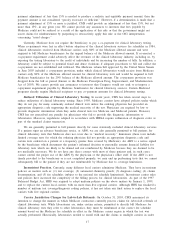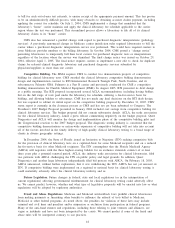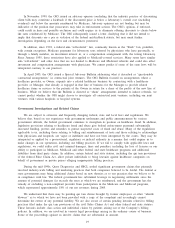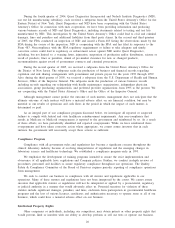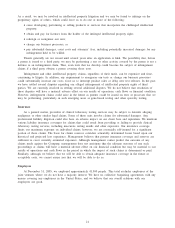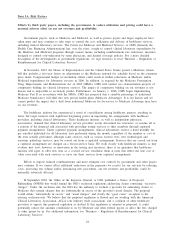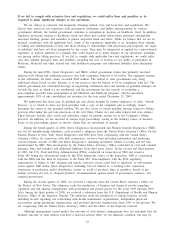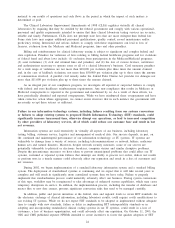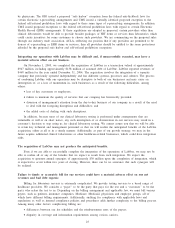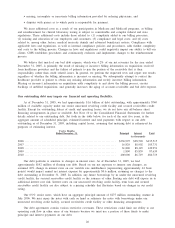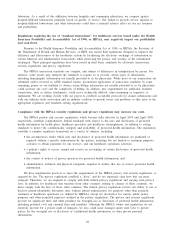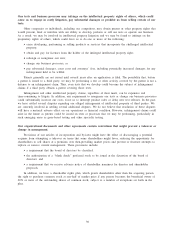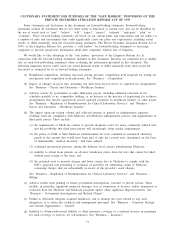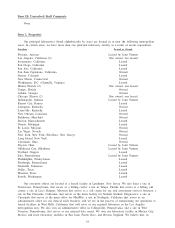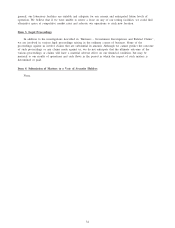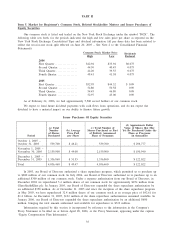Quest Diagnostics 2005 Annual Report Download - page 44
Download and view the complete annual report
Please find page 44 of the 2005 Quest Diagnostics annual report below. You can navigate through the pages in the report by either clicking on the pages listed below, or by using the keyword search tool below to find specific information within the annual report.We have obtained ratings on our debt from Standard and Poor’s and Moody’s Investors Service. There can
be no assurance that any rating so assigned will remain for any given period of time or that a rating will not
be lowered or withdrawn entirely by a rating agency if in that rating agency’s judgment future circumstances
relating to the basis of the rating, such as adverse changes in our company or our industry, so warrant. If such
ratings are lowered, the borrowing costs on our senior unsecured revolving credit facility, secured receivables
facility and term loan would increase. Changes in our credit ratings do not require repayment or acceleration of
any of our debt.
We, or our subsidiaries, may incur additional indebtedness in the future. Our ability to make principal and
interest payments will depend on our ability to generate cash in the future. If additional debt is added to our
current debt, a greater portion of our cash flows will be needed to satisfy our debt service obligations; and if
we do not generate sufficient cash to meet our debt service requirements, we may need to seek additional
financing. In this case, it may be more difficult, or we may be unable, to obtain financing on terms that are
acceptable to us. As a result, we would be more vulnerable to general adverse economic, industry and capital
markets conditions as well as the other risks associated with indebtedness.
Professional liability litigation could have an adverse financial impact and an adverse impact on our
client base and reputation.
As a general matter, providers of clinical laboratory testing services may be subject to lawsuits alleging
negligence or other similar legal claims. Some of these suits involve claims for substantial damages. Any
professional liability litigation could have an adverse impact on our client base and reputation. We maintain
various liability insurance programs for claims that could result from providing or failing to provide clinical
laboratory testing services, including inaccurate testing results and other exposures. Our insurance coverage
limits our maximum exposure on individual claims; however, we are essentially self-insured for a significant
portion of these claims. The basis for claims reserves considers actuarially determined losses based upon our
historical and projected loss experience. Management believes that present insurance coverage and reserves are
sufficient to cover currently estimated exposures. Although management cannot predict the outcome of any
claims made against the Company, management does not anticipate that the ultimate outcome of any such
proceedings or claims will have a material adverse effect on our financial condition but may be material to our
results of operations and cash flows in the period in which the impact of such claims is determined or paid.
Similarly, although we believe that we will be able to obtain adequate insurance coverage in the future at
acceptable costs, we cannot assure you that we will be able to do so.
Failure to provide a higher quality of service than that of our competitors could have a material adverse
effect on our net revenues and profitability.
While there has been significant consolidation in recent years in the clinical laboratory testing business, it
remains a fragmented and highly competitive industry. We believe that healthcare providers consider a number
of factors when selecting a laboratory, including:
•service capability and quality;
•accuracy, timeliness and consistency in reporting test results;
•number and type of tests performed by the laboratory;
•number, convenience and geographic coverage of patient service centers;
•reputation in the medical community; and
•pricing.
We believe that we compete favorably in each of these areas.
We primarily compete with three types of laboratory providers—hospital-affiliated laboratories, other
independent clinical laboratories and physician-office laboratories. Hospitals generally maintain an on-site
laboratory to perform testing on their patients. In addition, many hospitals compete with independent clinical
laboratories for outreach (non-hospital patients) testing. Most physicians have admitting privileges or other
relationships with hospitals as part of their medical practice and many hospitals leverage their relationships with
community physicians and encourage the physicians to send their outreach testing to the hospital’s laboratory. In
addition, hospitals that own physician practices generally require the physicians to refer tests to the hospital’s
27


